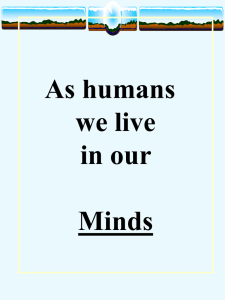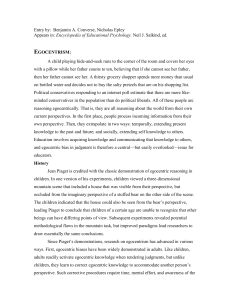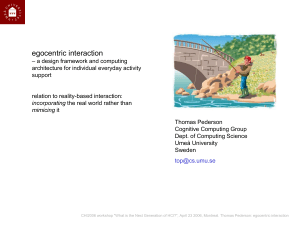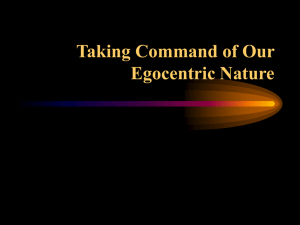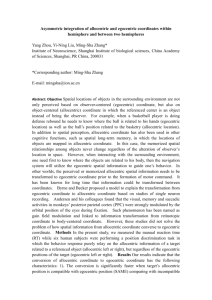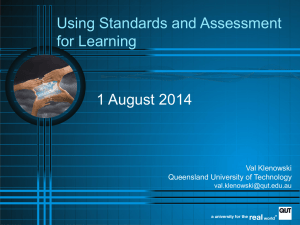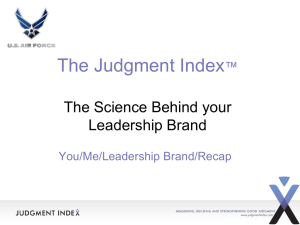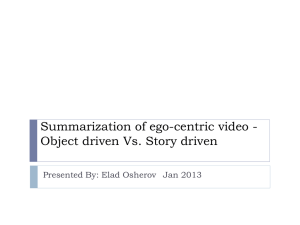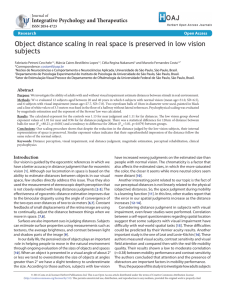Component Skills for the Agile Leader
advertisement
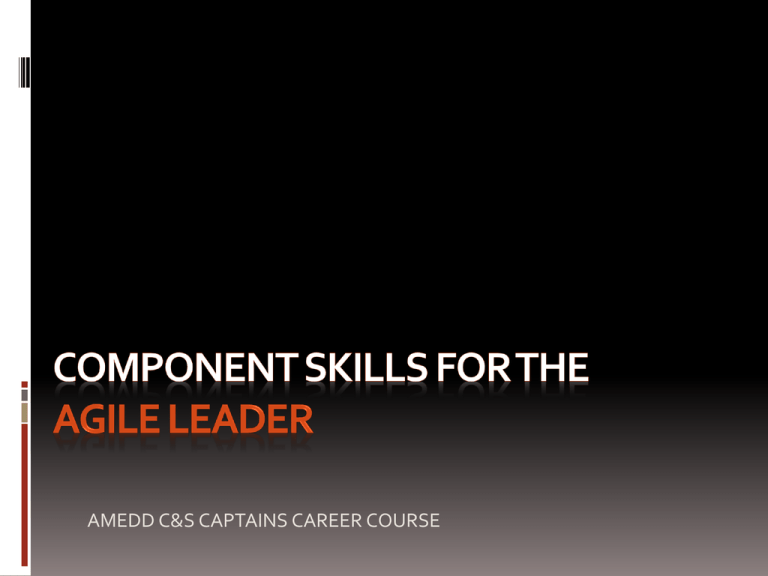
AMEDD C&S CAPTAINS CAREER COURSE OUTLINE Critical Thinking Mind-Sets / Mental Models Barriers to Critical Thinking Creative Thinking Exercise Conclusion Questions References 2-part process: 1) Thinking about thinking 2) Evaluating the results of that thinking ELEMENTS OF THOUGHT Generates PURPOSE Embodies a POINT OF VIEW Makes ASSUMPTIONS Generates IMPLICATIONS Utilizes CONCEPTS Uses INFORMATION Makes INFERENCES Raises QUESTIONS CRITICAL THINKING MODEL Requires critical thinking? Stimulus requiring judgment NO Make decision / Clarify position / Use judgment ASSUMPTIONS POINT OF VIEW INFERENCES YES Egocentric tendencies CLARIFY CONCERN EVALUATION OF INFORMATION Argument analysis IMPLICATIONS Impact of biases and traps EGOCENTRIC TENDENCIES Relatively common in military culture Egocentric memory Egocentric myopia Egocentric righteousness Egocentric blindness PERCEPTION: Why Can’t We See What Is There To Be Seen? PARIS IN THE THE SPRING ONCE IN A A LIFETIME BIRD IN THE THE HAND CRITICAL THINKING MODEL Requires critical thinking? Stimulus requiring judgment NO Make decision / Clarify position / Use judgment ASSUMPTIONS POINT OF VIEW INFERENCES YES Egocentric tendencies CLARIFY CONCERN EVALUATION OF INFORMATION Argument analysis IMPLICATIONS Impact of biases and traps MIND-SETS aka MENTAL MODELS Patterns of expectations on what to look for, what is important, and how to interpret what is seen that predisposes thinking to a certain way Mind-set is akin to a screen or lens through which one perceives the world Impressions Resist Change It is difficult to look at the same information from different perspectives Implications People form impressions on the basis of very little information, but once formed, they do not reject or change them unless they obtain rather solid evidence Limit the adverse impact of this tendency by suspending judgment for as long as possible as new information is being received If information does not fit into what people know, or think they know, they have great difficulty processing it CRITICAL THINKING MODEL Requires critical thinking? Stimulus requiring judgment NO Make decision / Clarify position / Use judgment ASSUMPTIONS POINT OF VIEW INFERENCES YES Egocentric tendencies CLARIFY CONCERN EVALUATION OF INFORMATION Argument analysis IMPLICATIONS Impact of biases and traps Military leaders need to continuously ask themselves the following questions… Is this something I need to think about critically? How are my point of view and egocentric tendencies affecting the way I look at this? What’s the point of view of the person presenting the information? What are my assumptions? Are we making the correct inferences based on the data provided? Are there data we need to consider and can access? Is the information true or at least plausible? Are the conclusions warranted by the evidence? Are biases and traps affecting our judgment? Have I considered all the implications? Cognitive Bias Psychological impediments Logical fallacies COGNITIVE BIAS Mental errors caused by our simplified information processing strategies Availability Heuristic: likelihood of event assessed by ease with which examples of that event can be brought to mind Representative Heuristic: make judgment based on how much item represents known item – sample size bias; regression to the mean Anchoring and Adjustment Heuristic: develop estimates from initial anchor and adjust from there to yield the final answer PSYCHOLOGICAL IMPEDIMENTS Loyalty, herd instinct, groupthink Prejudice, stereotypes, scapegoats Wishful thinking, mirror-imaging, self- deception Rationalization, denial Groupthink Symptoms Illusion of invulnerability Belief in inherent group morality Collective rationalization Out-group stereotypes Selfcensorship Illusion of unanimity Direct pressure on dissenters Self-appointed mind guards LOGICAL FALLACIES Common fallacies in MDMP Appeal to (unqualified) authority, fear, masses Slippery slope Straw man Arguments against the person False dichotomy False cause Red herring INTELLECTUAL STANDARDS CLARITY ACCURACY PRECISION RELEVANCE DEPTH BREADTH LOGIC SIGNIFICANCE FAIRNESS Problem-Solving Exercise MENTAL TOOLS Questioning Assumptions Seeing Different Perspective Thinking Backwards Devil’s Advocate Stimulating Creative Thinking BLUF: A questioning attitude is a prerequisite to a successful search for new ideas Problem to Solution Solution 1 Solution 2 Solution 3 This is not a test of intelligence. EXERCISE RULES OF ENGAGEMENT You will be asked to answer 2 questions that require reasoning These are not trick questions The information provided is true and complete – take it at face value You will have 60 seconds for each question This is not a test of intelligence – jot your answers on a piece of paper QUESTION 1 Each card has a letter on 1 side and number on the other. RULE: If the letter is a vowel, the number must be even. Which card(s) must you check at the minimum to ensure compliance with the rule? A B 4 7 QUESTION 2 Rule: You must be at least 21 to drink alcoholic beverages. Which reveler(s) must you check at the minimum to ensure compliance? She’s 23. He’s drinking wine. He’s drinking lemonade. She’s 19. EXERCISE RESULTS •Check the A to see that the number •Check the wine drinker to see that on the reverse is even. he’s at least 21. •Check the 7 to see that the letter •Check the 19 y/o to see that her on the reverse is not a vowel. drink is non-alcoholic. •The rule is not violated no matter •The rule is not violated no matter what number is behind the B or what letter is behind the 4. what the 23 y/o is drinking or how old the lemonade drinker is. CONCLUSION “Technological advances alone do not constitute change. The most dramatic advances in military operations over history have been borne of ideas – ideas about warfighting, organization, and doctrine. The Army’s most critical asset will not be technology; it will be critical thinking.” AUSA Torchbearer National Security Report, March 2005 Components Skills for the Agile Leader REFERENCES Thinking Critically About Critical Thinking: A Fundamental Guide for Strategic Leaders, Colonel Stephen J. Gerras, Ph.D., Director, Leadership and Command Instruction, U.S. Army War College, 1 June 2006 Psychology of Intelligence Analysis, Richards J. Heuer, Jr., Center for the Study of Intelligence, Central Intelligence Agency, 1999 How Critical Thinking Shapes the Military Decision Making Process, Floyd J. Usry, Jr., LtCol., USMC, Naval War College, 17 May 2004 Critical Thinking Competency Standards: Standards, Principles, Performance Indicators, and Outcomes with a Critical Thinking Master Rubric, Dr. Richard Paul and Dr. Linda Elder, www.criticalthinking.org, 2008 Fallacies: The Art of Mental Trickery and Manipulation, Dr. Richard Paul and Dr. Linda Elder, www.criticalthinking.org, 2008 RESOURCES ON THE WEB Foundations for Critical Thinking – http://www.criticalthinking.org/ Creativity, Thinking Skills, Critical Thinking, Problem Solving, Decision Making – http://www.au.af.mil/au/awc/awcgate/awcthkg.htm Tools, Techniques, Methods, Quotes on All Matters Creative – http://creatingminds.org/ Online Writing Lab at Purdue – http://owl.english.purdue.edu/owl/
